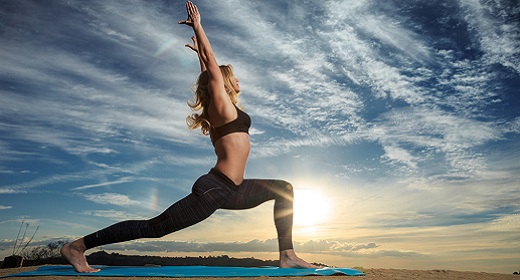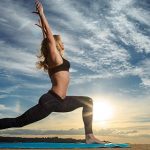by Jenn Dawson: Chaturanga, also known as Chaturanga Dandasana, is a yoga pose that moves from high plank to low plank…

or high to low push up. This pose is an asana, which means that it is a pose that is useful for restoring, improving, and maintaining well-being, flexibility and vitality.
Chaturanga Dandasana is translated to four-limbed staff pose; “Chatur” is Sanskrit for “four, “Anga” is Sanskrit for “limb”, “Danda” is Sanskrit for “staff”, and “Asana” is Sanskrit for “pose”. When done correctly, the body resembles a staff or rod with the spine in a straight line.
How to Practice Chaturanga
Chaturanga begins in plank pose, with a flat back and the body in a straight line, arms straight out and under the shoulders, thighs lifted, and toes tucked. The gaze is between the hands and the back of the neck is lengthened while the core is strong and pulled toward the spine.
The body slowly lowers on an exhale by bending the elbows without splaying them out the sides. The elbows should remain next to the body and in-line with the shoulders, pointing back toward the feet. Lower until the body hovers a few inches above the floor. The back remains flat.
Lift through the chest; do not let the chest drop toward the floor.
Roll forward on the toes to help the arms lower to a 90 degree angle. Keep the bases of the index fingers pressed into the floor.
The elbows and shoulders should be perpendicular with a 90 degree bend at the elbows.
Keep core muscles and leg muscles fully engaged.
Hold for 10-30 seconds, then continue lowering until the body rests gently on the mat.
Benefits
Practicing Chaturanga strengthens the arms, abdominal muscles, lower back, wrists, and muscles surrounding the spine. The pose helps to improve posture and prepares the body for other asanas and arm balances. Chaturanga tones and strengthens the full body.
Tips for Beginners
Chaturanga takes patience and time to achieve. When practicing for the first time, go slowly and gently, working within one’s own abilities.
If the pose is too difficult at first, drop to the knees first before lowering. This is Half Chaturanga. Practice Half Chaturanga until the arms and body can be fully supported with straight legs.
Remember to breathe during the asana. The elbows should remain hugged in toward the body the entire time and the core should remain engaged and pulled toward the spine. Keep the shoulders pulled back away from the ears and pointing forward, not allowing them to droop.
Variations
Advanced practitioners can come into the pose by beginning in Three-Legged Downward Dog (with one leg lifted in the air), moving into Three-Legged Plank Pose, and moving into Three-Legged Chaturanga. The same leg will remain lifted the entire time.
Another challenging variation involves rolling over the balls of the feet onto the tops of the feet while shifting the torso forward. The hands should be further back now, beside the waist. Continue the rest of the asana as normal.















































